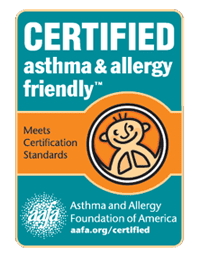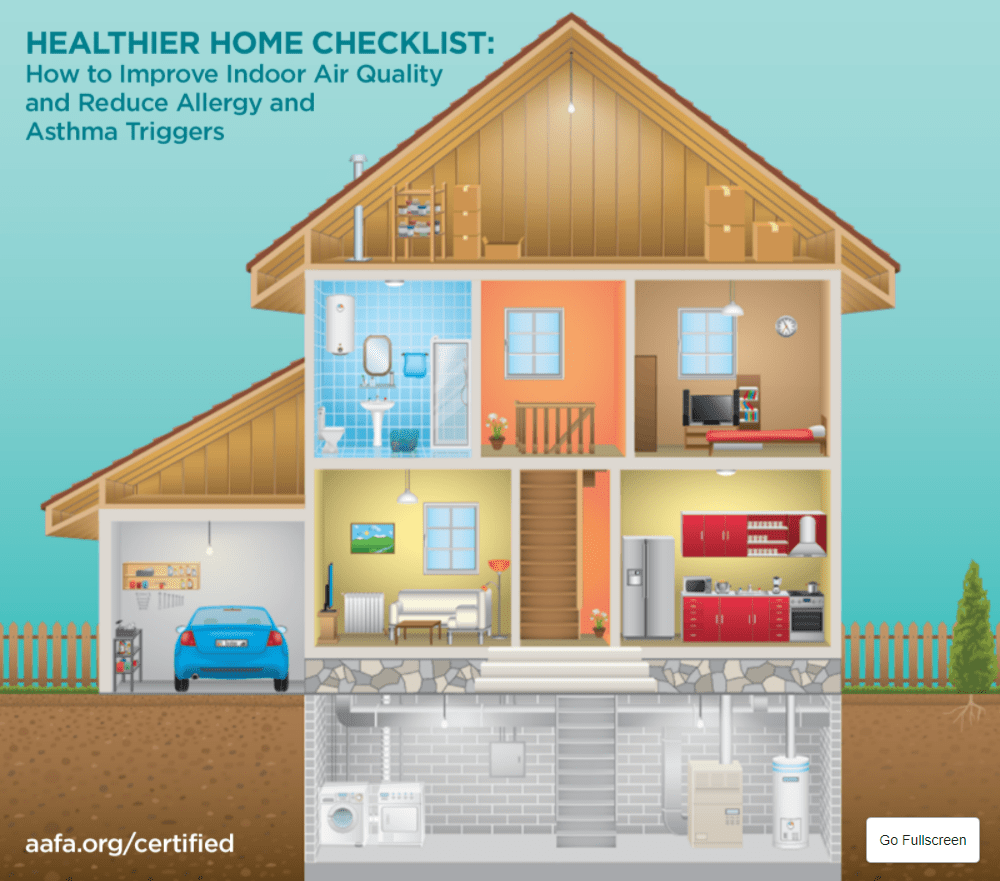Asthma
Indoor Air Quality
The following can affect indoor air quality:
Closed
Allergens
Indoor air can have a lot of allergens, like dust mites, pets, cockroaches, and mold.
Dust mites are tiny creatures that can be found in many homes. They thrive in furniture, carpets and bedding.
People with pet allergies are usually allergic to proteins in the pet’s urine, saliva, or dander (dead skin cells). Pet allergens can collect on many surfaces. Sometimes the allergens may remain at high levels for several months and cling to walls, furniture, clothing, and other surfaces.
Dust mites and pet dander can be found on:
- Surfaces
- Fabric furniture
- Curtains, throws, and pillows
- Carpets and rugs
- Bedding
- Under and on top of furniture
- Among clutter
Mold is a fungus that can be found both indoors and outside. Outdoors, you can find it on rotting wood, damp leaves, and on grasses and grains. When a mold source is disturbed, it can send spores into the air where they can make their way into your sinuses and lungs.
Inside, mold can be found:
- Near sinks, showers, and toilets
- Near water leaks, such as from appliances, pipes, and roofs
- In basements and damp or humid areas of your home
- In the soil of overwatered house plants
- On produce
Cockroaches can cause asthma and allergy symptoms year-round. They like warm conditions, damp places, and food sources. Even dead cockroaches can cause reactions.
Scents, Chemicals, and Other Sources of Indoor Air Pollution
Some other items in your home can release gasses called VOCs. This is called offgassing. VOCs can be 2 to 5 times higher indoors than outdoors.1 VOCs can have some short-term effects, but experts aren’t sure yet of long-term effects.
Sources of VOCs can include:
- New furniture
- New mattresses
- New carpet
- New building materials
- Paint and varnish
- Cleaning supplies
- Air fresheners
- Pesticides
Other sources of indoor air pollution include:
- Fuel-burning heat sources (like wood-burning stoves, kerosene heaters)
- Smoke from cooking, candles, fireplaces, or tobacco
- Attached garages that store cars, motorcycles, or lawnmowers (can add carbon monoxide to your air)
- Radon (a gas that comes from the ground and enters a home and can rise to dangerous levels)
Outdoor Air Pollution
Bad outdoor air quality can make asthma and allergies worse. And bad air can easily enter your home. No home is completely air tight. Outdoor air can come in through leaks around doors and windows. It can also come in every time you open a window or door. You can bring pollen and smoke particles inside on your clothing.
Allergens, scents, chemicals, and outdoor air in your home all work together to affect your indoor air quality.
Indoor Air Quality Resource Center
Why Healthy Indoor Air Quality Is Important: We spend around 90% of our time indoors. So it’s no wonder our indoor air can have such an impact on our health. Learn why and what you can do to improve the air in your home.
Sources of Air Pollution in Your Home That May Cause Asthma and Allergy Symptoms: It’s important to know what is polluting your air so you can improve and maintain good indoor air quality. Learn more about sources of air pollution around you.
Breathe Easier: Improving Indoor Air Quality in Your Bedroom: When trying to improve your indoor air, start in the bedroom. Follow these steps so you can improve your bedroom’s environment and sleep easier.
Breathe Easier: Improving Indoor Air Quality in Your Living Room: The living room is not only where everyone gathers, but it’s where allergens like to gather too. Follow these steps to make your living room more asthma and allergy friendly.
Breathe Easier: Improving Indoor Air Quality in Your Kitchen: You may not realize how many allergens and asthma triggers lurk in your kitchen. Follow these steps to reduce mold, pests, and more for a healthier kitchen.
Cleaning When You Have Asthma: The Dirty Truth: Cleaning can actually introduce asthma triggers and allergens while you’re trying to improve your indoor air quality. When you have asthma and allergies, you need to know the best way to clean.
Spring Cleaning for an Asthma and Allergy Friendly Home: Before you give your home a seasonal refresh, learn how to clean with asthma and allergies in mind.
Humidity’s Role in Asthma and Allergy Management: Humidity that’s out of balance can effect your indoor air. Learn what can happen if your house is too humid or too dry.
Air Cleaners: What You Need to Know: Air cleaners can be helpful tools for maintaining healthy indoor air. But there’s a lot you need to know before you shop for one.
Fact or Fiction: 5 Myths About Dust Mites: Dust mites are one of the most common allergens found indoors, but they can also be the trickiest to control. Find out the truth about dust mites so you know how to properly tackle them.
5 Asthma and Allergy Tips for a Healthier Home for the Holidays: The holidays can bring more than just parties and cheer. They can also introduce allergens and asthma triggers. Deck the halls in ways that are healthier for your home.
Healthier Home Checklist: Good indoor air quality is an important part of asthma and allergy management. Use our interactive Healthier Home Checklist to help you improve your indoor air quality and reduce allergy and asthma triggers around your home.

Look for this mark to find products proven more suitable for people with asthma and allergies.
Find CERTIFIED asthma & allergy friendly® products on our certification program website.
References
1. Volatile Organic Compounds’ Impact on Indoor Air Quality. (2017, April 19). Retrieved September 14, 2017, from www.epa.gov/indoor-air-quality-iaq/volatile-organic-compounds-impact-indoor-air-quality
Using CERTIFIED asthma & allergy friendly® products in your home can help you have a healthier indoor environment, as well as reduce allergens.
To learn more about the asthma & allergy friendly® Certification Program, visit: aafa.org/certified.
Allergy Capitals
Top 100 Metro Area Rankings
Pollen Allergy Report>











